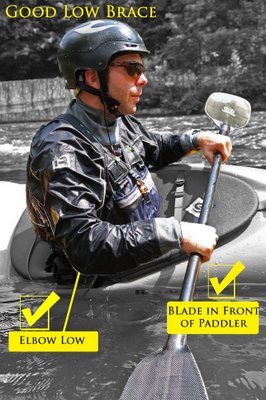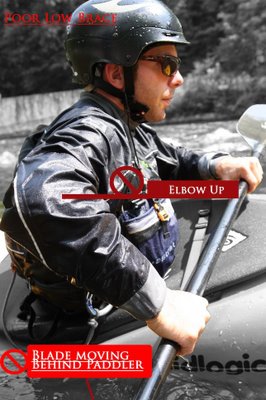Sculling Draw
Sculling draw strokes are just another way to smoothly pull yourself across the water sideways. The sculling draw stroke shares a great deal of similarity to the sweeping motion of a sweep roll except you are upright and the paddle shaft is higher of course. As with all draws, you need to turn your torso sideways facing where you are going. You move the paddle blade from front to back in a gentle arc and keep repeat vice versa. A great way to start practicing the roll is leaning the boat on its edge and perform the sculling draw. Here is a good demonstration of this stroke: Sculling Draw Stroke.
Stationary Draw
Another variant of the draw stroke is a stationary draw stroke. This stroke can be very helpful for eddy turns. It can also be used to move sideways when under speed with little or no effort. The keys to a stationary draw are speed and paddle angle. Bow draws typically use an open power face and require a fair amount of speed to be effective. Gliding draws are done from the rear of the boat and are very similar to a rudder stroke except the paddle shaft is held more vertical. The are used to control and stop spin. They use the non-power side of the paddle blade, just like a rudder. Here is a good example of one used to catch an eddy: Gliding Eddy Turn. Here is another variation of the stationary draw stroke: Static Bow Draw. You can also move the somewhat stationary draw from the from to the back of the boat to glide gently sideways. This takes some practice and isn't commonly used in whitewater.
Duffek and other draw variations
Introduction
The Duffek Stroke is often used to quickly peel out of an eddy into fast moving water. Instead of simply blasting our way out and across the river, in some cases we want a very tight escape and turn downstream. This technique uses a stationary draw stroke. Here is a very detailed explanation of the technique along with a demonstration: Duffek Stroke. In this demonstration, a gliding bow draw is used to escape an eddy in whitewater: Gliding Bow Draw.
The Boof Stroke
The boof stroke is really an advanced move to ski jump over obstacles like holes or to flat land your kayak in places you really don't want to pencil in or piton. I am including it here since it is often mentioned on paddle club forums and is often combined with a draw stroke to make last minute corrections: The Boof Stroke.
Low Brace
 Bracing is one of the ways we prevent ourselves from tipping over in a kayak. There are two basic types of braces, the high brace and the low brace. Where possible, try to use the low brace as it is much safer. Several paddle strokes start with the low brace, most notably the back stroke and the reverse sweep. Paddlers that properly surf holes heavily use the low brace to establish their balance. The low brace uses the back side of the blade, knuckles down. The low brace quickly taps the surface of the water with the back side of the paddle blade. As with all braces, return your head to the upright position last. Use your hips to rotate the boat upright. Low braces work best on the front half of the boat.
Bracing is one of the ways we prevent ourselves from tipping over in a kayak. There are two basic types of braces, the high brace and the low brace. Where possible, try to use the low brace as it is much safer. Several paddle strokes start with the low brace, most notably the back stroke and the reverse sweep. Paddlers that properly surf holes heavily use the low brace to establish their balance. The low brace uses the back side of the blade, knuckles down. The low brace quickly taps the surface of the water with the back side of the paddle blade. As with all braces, return your head to the upright position last. Use your hips to rotate the boat upright. Low braces work best on the front half of the boat.
 The key safety item to watch out for is stay inside the paddlers box - don't let the rear blade get out of sight.
The key safety item to watch out for is stay inside the paddlers box - don't let the rear blade get out of sight.
Here is a great article on shoulder safety: Shoulder Safety.
Here is a short video on the brace strokes from Mike Aronoff of CKAPCO: Bracing Strokes.
Another great video from Janey Cowie of Zoar Outdoors: High & Low Bracing.
Page 1 of 4
